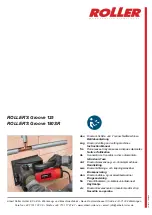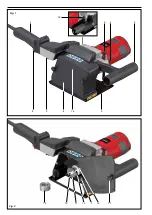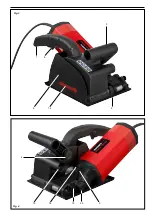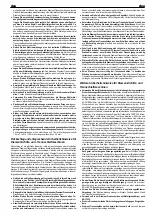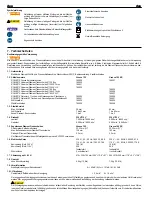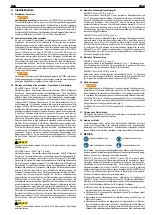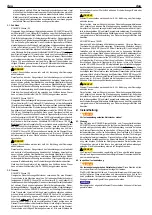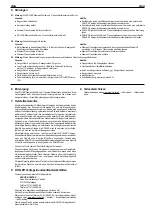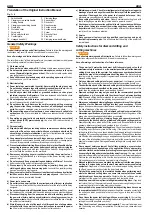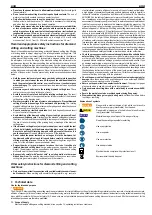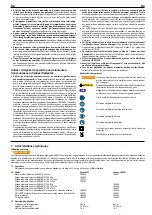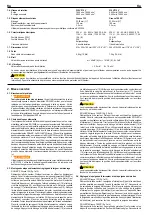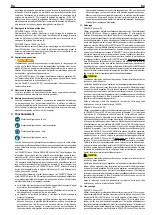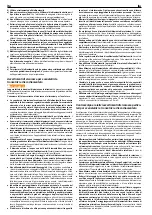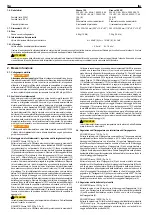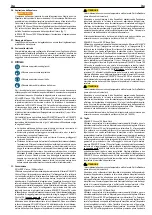
Translation of the Original Instruction Manual
Fig. 1 – 4
1 Switch handle
2 Clamping screw switch handle
3 Holding handle
4 Clamping screw holding handle
5 Depth stop
6 Protective cover
7 Screw axle
8 Safety switch with lock
9 Contact plate
10 Hexagon head bolt
11 Clamping flange
12 Spacer discs
13 Drive shaft
14 Direction arrow
15 Suction nozzle
16 Suction nozzle adapter
17 Screw
18 Drive shaft lock
19 Stop bolt
20 Clamping screw depth stop
General Safety Warnings
WARNING
Read all safety warnings and all instructions.
Failure to follow the warnings and
instructions may result in electric shock, fire and/or serious injury.
Save all warnings and instructions for future reference.
The term "power tool" in the warnings refers to your mains-operated (corded) power
tool or battery-operated (cordless) power tool.
1) Work area safety
a) Keep work area clean and well lit.
Cluttered or dark areas invite accidents.
b) Do not operate power tools in explosive atmospheres, such as in the pres-
ence of flammable liquids, gases or dust.
Power tools create sparks which
may ignite the dust or fumes.
c) Keep children and bystanders away while operating a power tool.
Distrac-
tions can cause you to lose control.
2) Electrical safety
a) Power tool plugs must match the outlet. Never modify the plug in any way.
Do not use any adapter plugs with earthed (grounded) power tools.
Unmod-
ified plugs and matching outlets will reduce risk of electric shock.
b) Avoid body contact with earthed or grounded surfaces, such as pipes,
radiators, ranges and refrigerators.
There is an increased risk of electric shock
if your body is earthed or grounded.
c) Do not expose power tools to rain or wet conditions.
Water entering a power
tool will increase the risk of electric shock.
d) Do not abuse the cord. Never use the cord for carrying, pulling or unplug
-
ging the power tool. Keep cord away from heat, oil, sharp edges or moving
parts.
Damaged or entangled cords increase the risk of electric shock.
e) When operating a power tool outdoors, use an extension cord suitable for
outdoor use.
Use of a cord suitable for outdoor use reduces the risk of electric
shock.
f) If operating a power tool in a damp location is unavoidable, use a residual
current device (RCD) protected supply.
Use of an RCD reduces the risk of
electric shock.
3) Personal safety
a) Stay alert, watch what you are doing and use common sense when operating
a power tool. Do not use a power tool while you are tired or under the influ
-
ence of drugs, alcohol or medication.
A moment of inattention while operating
power tools may result in serious personal injury.
b) Use personal protective equipment. Always wear eye protection.
Protective
equipment such as dust mask, non-skid safety shoes, hard hat, or hearing protec-
tion used for appropriate conditions will reduce personal injuries.
c) Prevent unintentional starting. Ensure the switch is in the off-position before
connecting to power source and/or battery pack, picking up or carrying the
tool.
Carrying power tools with your finger on the switch or energising power
tools that have the switch on invites accidents.
d) Remove any adjusting key or wrench before turning the power tool on.
A
wrench or a key left attached to a rotating part of the power tool may result in
personal injury.
e) Do not overreach. Keep proper footing and balance at all times.
This enables
better control of the power tool in unexpected situations.
f) Dress properly. Do not wear loose clothing or jewellery. Keep your hair,
clothing and gloves away from moving parts.
Loose clothes, jewellery or long
hair can be caught in moving parts.
g) If devices are provided for the connection of dust extraction and collection
facilities, ensure these are connected and properly used.
Use of dust col -
lection can reduce dust-related hazards.
4) Power tool use and care
a) Do not force the power tool. Use the correct power tool for your application.
The correct power tool will do the job better and safer at the rate for which it was
designed.
b) Do not use the power tool if the switch does not turn it on and off.
Any power
tool that cannot be controlled with the switch is dangerous and must be repaired.
c) Disconnect the plug from the power source and/or the battery pack from
the power tool before making any adjustments, changing accessories, or
storing power tools.
Such preventive safety measures reduce the risk of starting
the power tool accidentally.
d) Store idle power tools out of the reach of children and do not allow persons
unfamiliar with the power tool or these instructions to operate the power
tool.
Power tools are dangerous in the hands of untrained users.
e) Maintain power tools. Check for misalignment or binding of moving parts,
breakage of parts and any other condition that may affect the power tool’s
operation. If damaged, have the power tool repaired before use.
Many
accidents are caused by poorly maintained power tools.
f) Keep cutting tools sharp and clean.
Properly maintained cutting tools with
sharp cutting edges are less likely to bind and are easier to control.
g) Use the power tool, accessories and tool bits etc. in accordance with these
instructions, taking into account the working conditions and the work to
be performed.
Use of the power tool for operations different from those intended
could result in a hazardous situation.
5) Service
a) Have your power tool serviced by a qualified repair person using only
identical replacement parts.
This will ensure that the safety of the power tool
is maintained.
Safety instructions for diamond slitting and
cutting machines
WARNING
Read all safety warnings and all instructions.
Failure to follow the warnings and
instructions may result in electric shock, fire and/or serious injury.
Save all warnings and instructions for future reference.
●
The power tool's protective hood must be fitted securely and set so that
maximum safety is achieved, i. e. the smallest possible part of the diamond
cutting disc is open to the operator. You and persons nearby should stand
outside the area of the rotating diamond cutting discs.
The protective hood
should protect the operator against fragments and accidental contact with the
diamond cutting discs.
●
Only use diamond cutting discs for your power tool.
Just because you can
fit a cutting disc to your power does not automatically guarantee its safe use.
●
The admissible speed of the diamond cutting disc must be at least as high
as the maximum speed specified on the power tool.
Accessories which turn
faster than the admissible speed can break and fly about.
●
Diamond cutting discs may only be used for the recommended possible
applications, e.g.: Never grind with the side surface of a diamond cutting
disc.
Diamond cutting discs are intended for removal of material with the edge
of the disc. Lateral forces on the grinding body can bread it.
●
Always use undamaged clamping flanges and spacer discs of the right size
and shape for the diamond cutting discs that you have chosen.
Suitable
flanges and spacer discs support the diamond cutting discs and therefore reduce
the risk of breakage of the diamond cutting discs.
●
Outer diameter and thickness of the diamond cutting discs must match the
dimension specifications of your power tool.
Diamond cuttings discs of the
wrong size cannot be adequately shielded or controlled.
●
The diamond cuttings discs, clamping flange and spacer discs must fit
exactly onto the drive shaft of your diamond slitting and cutting machine.
Diamond cutting discs which do not fit the power tool's drive shaft exactly rotate
unevenly, vibrate very strongly and can lead to loss of control.
●
Do not use damaged diamond cutting discs.
Check the diamond cutting discs
for splitting and cracks every time before using. If the power tool or a diamond
cutting disc falls to the ground, check whether the diamond cutting disc has been
damaged. Only use undamaged diamond cutting discs. When you have checked
and fitted the diamond cutting discs, you and persons nearby should stand outside
the area of the rotating diamond cutting discs and let the power tool run for one
minute at maximum speed. Damaged diamond cutting discs usually break in this
test time.
●
Wear personal safety equipment. Use full face protection, eye protection
or protective glasses depending on the application. Where appropriate,
wear a dust mask, ear defenders, protective gloves or special aprons which
keep small grinding and material particles away from you.
The eyes should
be protected against flying foreign bodies which occur in different applications.
Dust masks and respirators must filter the dust produced in the application.
Prolonged exposure to loud noise can lead to loss of hearing.
●
Make sure that other persons are standing well away from the area you are
working in. Everyone who enters the work area must wear personal safety
equipment.
Fragments of the workpiece or broken diamond cutting discs can
fly off and cause injury even outside the direct work area.
●
Only hold the power tool by the insulated handles when performing work
where the diamond cutting discs can come into contact with concealed
electric cables or its own power cable.
Contact with a live cable can also put
metal parts of the power tool under voltage and lead to electric shock.
●
Keep the power cable away from rotating diamond cutting discs.
If you lose
control over the tool, the power cable could be severed or caught and your hand
or arm could get into the rotating diamond cutting disc.
●
Never put down the power tool until the diamond cutting discs have come
to a complete standstill.
Rotating diamond cutting discs can make contact with
the surface on which you put down the tool, causing you to lose control of the
power tool.
●
Do not leave the power tool running while you are carrying it.
Your clothing
could accidentally get caught in the rotating diamond cutting discs and the diamond
cutting discs could penetrate your body.
●
Clean the air vents of your power tool regularly.
The motor fan draws dust
into the housing and a heavy accumulation of metal dust can cause electrical
hazards.
eng eng
Содержание Groove 125
Страница 2: ...Fig 2 10 13 11 12 Fig 1 1 2 3 4 5 6 14 9 8 15 7 12 17 16 18...
Страница 3: ...Fig 4 Fig 3 1 8 3 14 9 6 15 18 5 20 19 4...
Страница 55: ......

